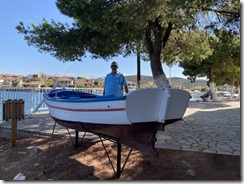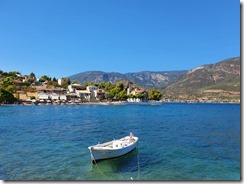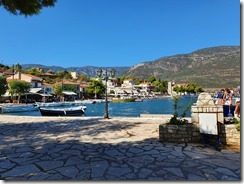Our next destination was Galaxidhi, a small fishing town on the Gulf of Corinth. As we approached through a selection of small islands and a narrow navigation channel, we could see the two natural ports ahead of us. It felt like we were approaching another island but, in fact, Galaxidhi sits on the mainland not far from Delphi and within easy reach of Athens.
Galaxidi was only accessible by boat until 1963. For many years, the town was home to Greece’s most important shipping families, and their grand houses with wrought-iron balconies, stone figureheads, pebbled courtyards and brightly painted shutters, still line the waterfront along with a choice of the many restaurants and quaint shops including a gorgeous chocolate shop which we tried to avoid but failed!!
Worth a visit is the Nautical Historical Museum, which tells the tale of the town and its role in the Greek War of Independence through a series of engaging exhibits.
Opposite the quay where we moored Money Penny was the forested headland known as Pera Panta. We took a walk out to the headland past sandy coves for swimming and areas of rocks along the waters edge suitable for sunbathing.
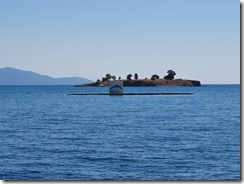
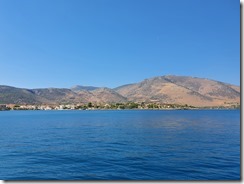
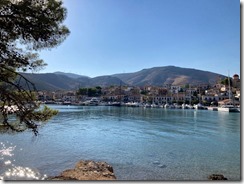 Alex & Kuni joined us in Galaxidhi and we rented a car together the day after our arrival, before heading out to explore the surrounding area. On our way to Delphi we passed beautiful countryside, including olive groves with irrigation canals stretching for miles, and also stopped for a coffee break at a hilltop restaurant with the most amazing views.
Alex & Kuni joined us in Galaxidhi and we rented a car together the day after our arrival, before heading out to explore the surrounding area. On our way to Delphi we passed beautiful countryside, including olive groves with irrigation canals stretching for miles, and also stopped for a coffee break at a hilltop restaurant with the most amazing views.
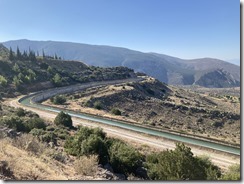
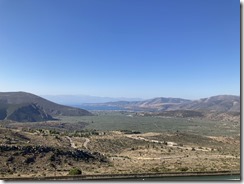
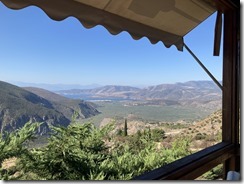 According to Greek mythology, Zeus released two eagles from either side of the ancient world and they met at Delphi, the centre of the Greek universe. Gaia, the primal Mother Earth goddess, was also said to reside here, and Delphi became one of the most sacred sites in the ancient world.
According to Greek mythology, Zeus released two eagles from either side of the ancient world and they met at Delphi, the centre of the Greek universe. Gaia, the primal Mother Earth goddess, was also said to reside here, and Delphi became one of the most sacred sites in the ancient world.
Delphi is a UNESCO World Heritage Site on the slopes of Mount Parnassus. Understandably, the site would normally attract large numbers of visitors but again, due to Covid, coupled with the fact that we arrived early in the morning, we were lucky to share the site with very few other visitors. We entered and climbed the long track, known as the Sacred Way, which lead to the Temple of Apollo at the top of the hill.
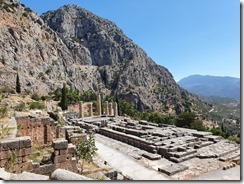 All that remains of the temple today are the foundations. The stones are cut into unusual polygonal shapes and carved with inscriptions, many of which relate to the emancipation of slaves.
All that remains of the temple today are the foundations. The stones are cut into unusual polygonal shapes and carved with inscriptions, many of which relate to the emancipation of slaves.
Above the Temple of Apollo sits the theatre, which dates from the 4th century BC. It’s still well preserved, and you can climb to the top tier of the seating for views of ancient Delphi, the surrounding mountains and the valley below. It was amazing. When built, the theatre had enough seating for 5,000 spectators and was used during the Pythian Games, held at Delphi every four years from 590 BC
.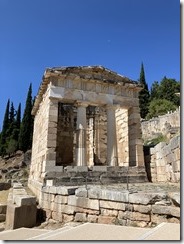
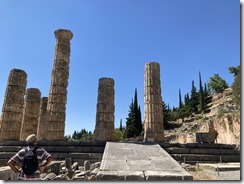
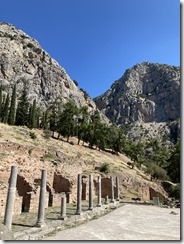
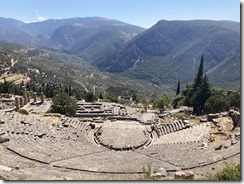
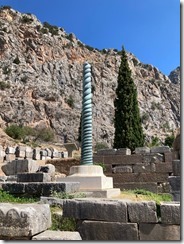
In 2015, a replica of the Serpentine Column, a bronze pillar erected to commemorate the defeat of the Persian Empire at the Battle of Plataea in 479 BC, was added to the site.
 The Stadium was built to host the athletics of the Pythian Games, it was changed by the Romans in the 2nd century and has well-preserved tiered stone seating. A running track with carved stone starting blocks is at the centre and close by is the gymnasium, which had an outside track. Unfortunately this area is roped off but we had a clear view looking down on it from where we stood.
The Stadium was built to host the athletics of the Pythian Games, it was changed by the Romans in the 2nd century and has well-preserved tiered stone seating. A running track with carved stone starting blocks is at the centre and close by is the gymnasium, which had an outside track. Unfortunately this area is roped off but we had a clear view looking down on it from where we stood.
After walking around the impressive ruins of Delphi we visited the Archaeological Museum, this housed the most amazing collection of treasures found in ancient Delphi. The Museum sits within the grounds of the site and displays its collection in chronological order. The highlights included a life-size bronze charioteer and the Sphinx of Naxos dating from 560 BC. We were also ‘blown away’ by the intricacy of some of the smaller artefacts.
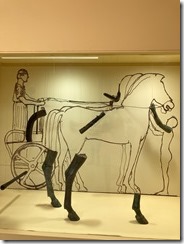
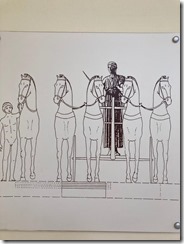
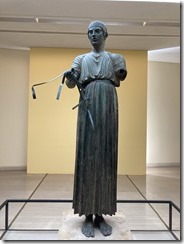
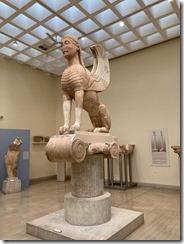
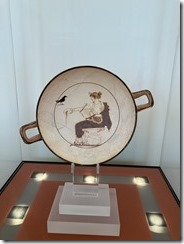
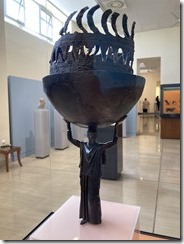
After our trip to the Historical site we had lunch together in the town before heading back to Galaxidhi for one more evening before moving on. We highly recommend this area and would love to return next year.
Trizonia
On the 12th September we departed Galaxidhi and travelled 15 miles west to the small island of Trizonia. The island is 2.5 sq km and has a population of only 64. (according to the 2011 census). We entered the marina and moored along one of the concrete quays. The marina was rundown, full of old boats that looked like they had been abandoned and there was no office anywhere in sight. Our overnight stay was free of charge!
Just off the marina there was a sheltered area to take an afternoon swim and the walk around the headland took us to the pretty harbour and village. The village was accessible directly from the marina but we chose to take a walk. A sleepy place to just relax and chill!
